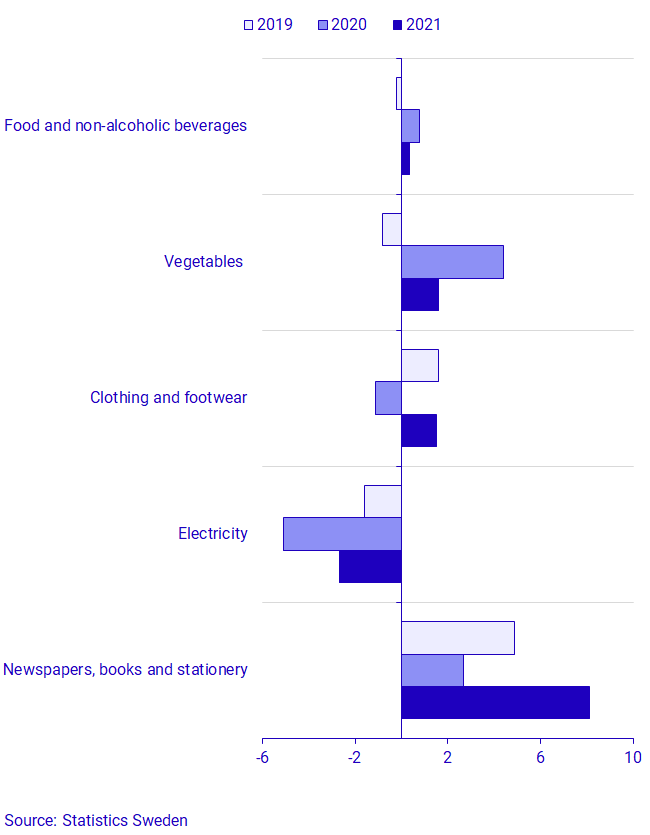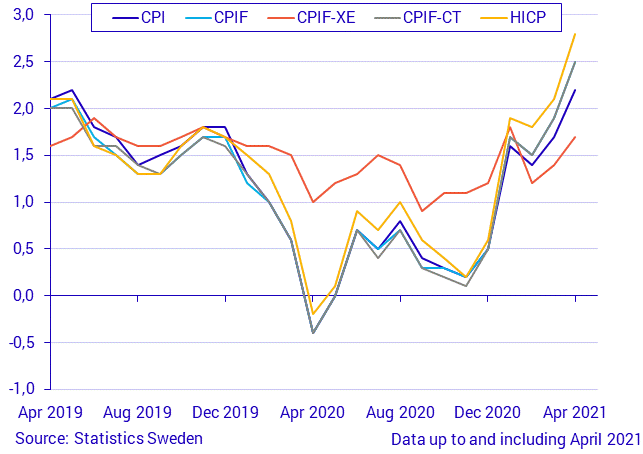Consumer Price Index (CPI), April 2021
Inflation rate was 2.5 percent in April 2021
Statistical news from Statistics Sweden 2021-05-12 9.30
The inflation rate according to the CPIF (Consumer Price Index with fixed interest rate) was 2.5 percent in April 2021, up from 1.9 percent in March. The increase in the inflation rate mainly comes from a dramatic drop in prices in the corresponding period a year ago. The change on a monthly basis between March and April was 0.3 percent.
“It is now a year since the pandemic clearly impacted the prices. The sharp drop in prices in April last year is now resulting in an upward effect on the inflation rate,” says Caroline Neander, statistician at Statistics Sweden.
In brief
| Index Numbers |
Monthly changes, percent |
Annual changes, percent |
|
|---|---|---|---|
| CPI (1980=100) | 340.37 | 0.2 | 2.2 |
| CPIF (1987=100) | 222.98 | 0.3 | 2.5 |
| CPIF-XE (1987=100) | 210.54 | 0.4 | 1.7 |
- Significantly higher electricity and fuel prices compared with the same period last year affected inflation upwards in April.
- Prices increased on books after the book sale last month.
- The inflation rate according to CPIF excluding energy increased from 1.4 percent in March to 1.7 percent in April.
- 0.8 percent of the basket was imputed due to absence of consumption.
Higher prices on clothing and footwear offset by lower electricity prices
The CPIF increased by 0.3 percent from March to April. In the corresponding period a year ago, the CPIF decreased by 0.3 percent.
The main contribution to the CPIF monthly rate came from increased prices on books after the book sales in March. Prices on clothing and footwear increased. Prices on food, mainly vegetables, and non-alcoholic beverages also increased. This upturn was offset by lower electricity prices.
The table below shows changes on a monthly basis and contributions to the CPIF based on the goods and services that had the greatest impact on the CPIF in April 2021. The results are presented by COICOP category; COICOP refers to the United Nations classification of household consumption expenditure.
| Category (Coicop) | Monthly changes, percent |
Contribution to CPIF Monthly change, percentage points |
|---|---|---|
| Food and non-alcoholic beverages (01) | 0.4 | 0.1 |
| Clothing and footwear (03) | 1.5 | 0.1 |
| Electricity (04.5.1) | ‑2.7 | ‑0.1 |
| Newspapers, books and stationery (09.5) | 8.1 | 0.1 |

Seasonal patterns and temporary price changes
Price changes on goods and services may be seasonal or temporary. The figure above shows the monthly changes this year and in the two most recent years for the goods and services with the largest impact on the CPIF monthly change.
Food and non-alcoholic beverage prices increased in April 2021. As last year, prices on vegetables rose, unlike in same period in 2019, when they fell. Cauliflower and sweet pepper are some of the products that rose sharply in price and contributed to the upturn in this period.
The prices of clothing and footwear increased in April 2021, while in the same period in 2020, prices fell instead. Electricity prices fell in April, as they did in the same period in the last two years. However, prices fell less this year than in 2020.
Prices on newspapers, books and stationery increased in April 2021, as they have done in the last two years and is a seasonal return to normal prices following the annual book sale. Higher prices on popular magazines and subscriptions also provided an upward contribution to the increased rate.
Contribution to the inflation rate in April
The inflation rate according to the CPIF, that is, the change in the CPIF over the past 12-month period, was 2.5 percent in April 2021, up from 1.9 percent in March. In April 2020, the consequences of the pandemic emerged, as prices for fuel, electricity, clothes, accommodation and gyms fell sharply. Inflation then dropped to -0.4 percent. The exceedingly low prices during the comparison period then had an upward effect on the inflation rate in April 2021.
An upward contribution to the inflation rate came from rising transport prices, in particular driven by rising fuel prices. Housing costs also increased, mainly because the level of electricity prices was significantly higher in April this year than in the corresponding period a year ago.
Clothing and footwear prices usually increase in April, although last year in the same period prices fell, which resulted in an upward contribution to the inflation rate in April 2021. Miscellaneous goods and services also provided an upward contribution to the inflation rate.
Within the group recreation and culture, other recreational items, camping and open-air recreation provided upward contributions, downward contributions from audiovisual, photographic equipment and computer equipment offset the rising price development.
The inflation rate according to the CPIF excluding energy was 1.7 percent in April, up from 1.4 percent in March.
| Category (Coicop) | Yearly change, percent |
Contribution yearly change CPIF percentage points |
|---|---|---|
| Clothes and shoes (03) | 7.2 | 0.3 |
| Housing (04) | 3.8 | 0.9 |
| Electricity (04.5.1) | 12.9 | 0.4 |
| Transport (07) | 6.5 | 0.8 |
| Fuel (07.2.2) | 21.3 | 0.5 |
| Recreation and culture (09) | 1.6 | 0.2 |
| Audio-visual, photographic and information processing equipment (09.1) | ‑9.1 | ‑0.2 |
| Miscellaneous goods and services (12) | 2.2 | 0.2 |
Other measures of inflation
Statistics Sweden calculates different inflation measures for different purposes. The CPIF is the Riksbank’s target variable, while the CPI is the measure used for purposes of compensation.

Effects of the coronavirus pandemic on calculations
As a result of the coronavirus pandemic, some services in the CPIF basket were unavailable to consumers to purchase in April. As in previous months, prices for these services have been imputed. The share of imputed prices was 0.80 percent in April. For further information, see the document “Special imputations during the coronavirus pandemic”.
Definitions and explanations
The CPIF shows the same price trend as the CPI, but without the direct effects of a changed monetary policy. The CPIF is the Riksbank’s target variable for the inflation target.
The CPIF excluding energy (CPIF-XE) and the CPIF with constant tax (CPIF-CT) are two other measures of inflation produced by Statistics Sweden on behalf of the Riksbank. In the CPIF-XE, energy products are excluded from the CPIF, while in the CPIF-CT the taxes and subsidies associated with the products in the CPIF are kept constant.
The HICP (Harmonised Index of Consumer Prices) is produced by all EU Member States. This measure has a somewhat smaller coverage than the CPI and the CPIF, mainly because parts of households’ housing costs are omitted.
Next publishing will be
2021-06-10 at 9:30.
Statistical Database
More information is available in the Statistical Database
Feel free to use the facts from this statistical news but remember to state Source: Statistics Sweden.
